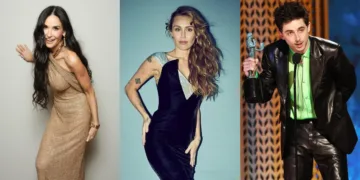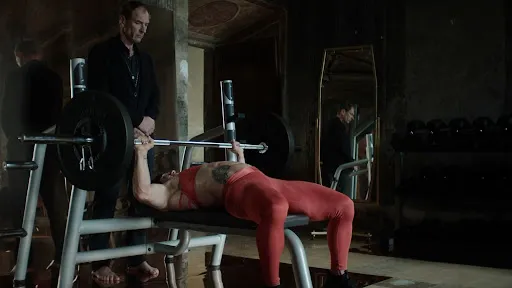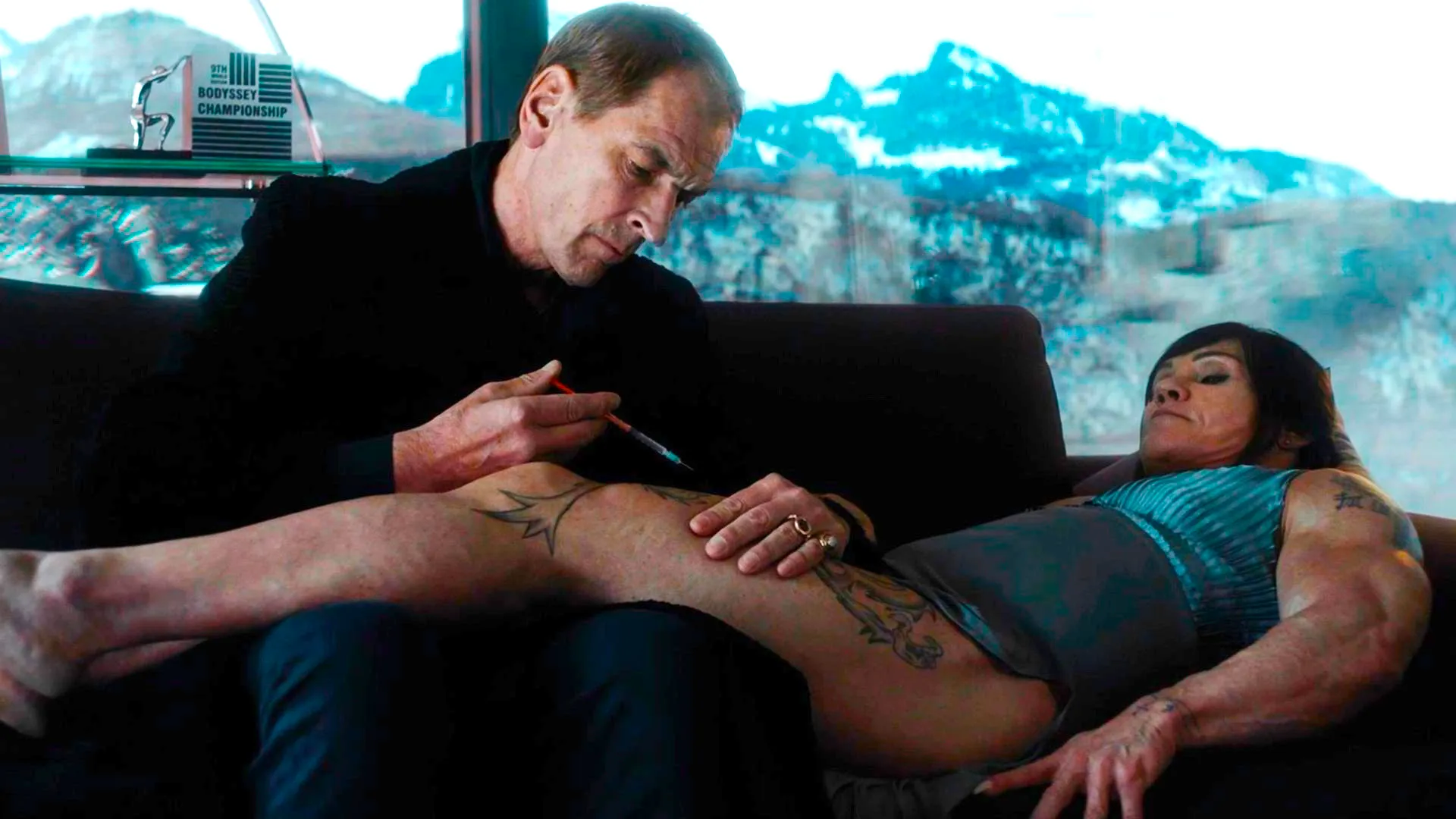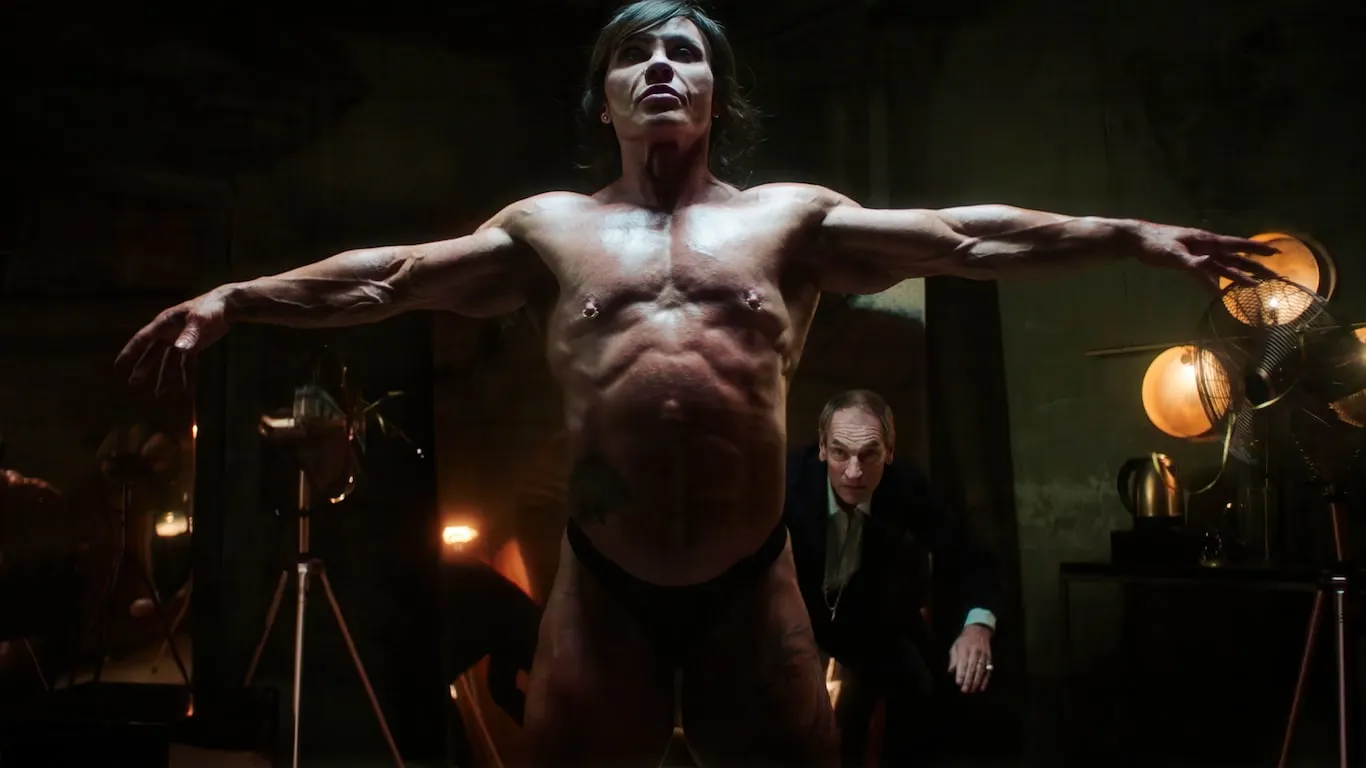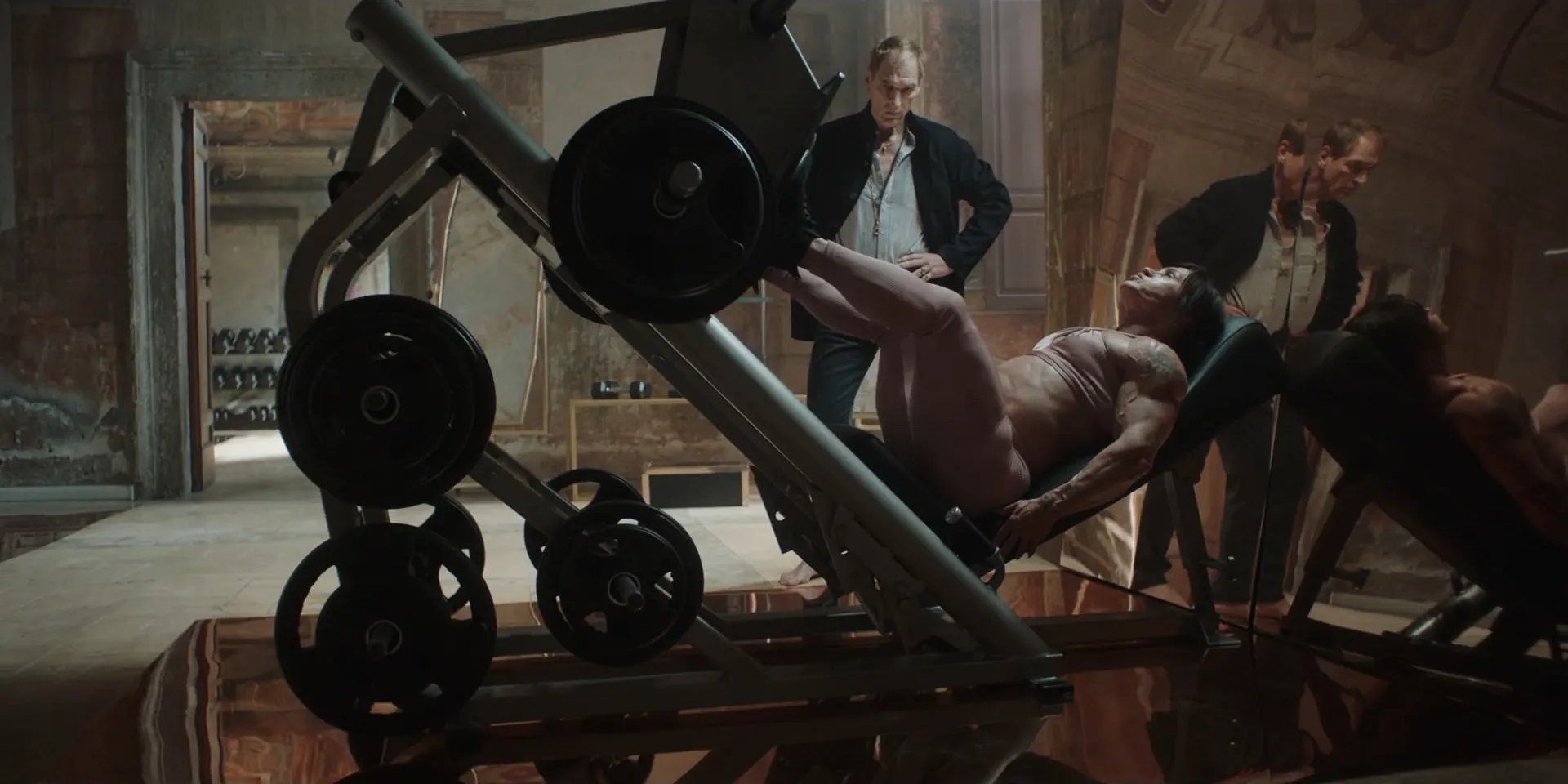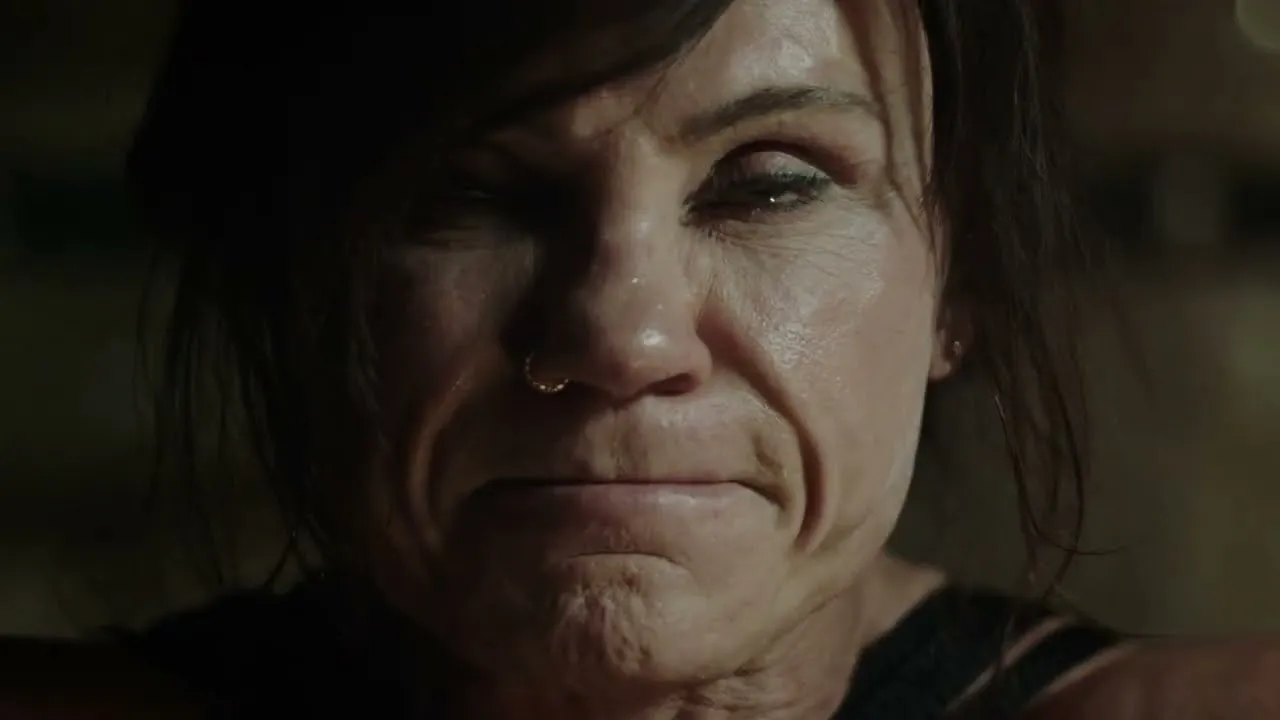Body Odyssey opens on Mona immersed in ritualized training, each clang of iron and hiss of steroids marking her devotion to a form that exceeds usual human scale. We meet her through a clinical lens—long takes of muscle fibers contracting, close‑ups of injected syringes—yet beneath this precision lies a surreal undercurrent, as if we’ve stepped into an experimental French New Wave gym.
Mona’s quest for the Miss Body Universe crown drives every scene. Early moments anchor us in her disciplined routine: dawn lifts, calorie counts, whispered self‑affirmations. As her regimen intensifies, the film shifts structure, intercutting her present labors with flickering memories of solitude and brief encounters with Nic, the younger man whose fleeting warmth unsettles her equilibrium. These nonlinear glimpses of longing fracture the narrative, inviting us to assemble Mona’s psyche from shards of image and sound.
Tricarico stakes her claim in body‑horror–tinged cinema, yet she resists pure pastiche. Moments of distortion—Mona’s voice echoing from her own body, a fractured reflection in a gym mirror—feel earned, tied to her spiraling control. Cinematographer Corrado Serri’s sterile palettes collide with sudden bursts of red and shadow, underscoring the tension between Mona’s sculpted shell and her faltering mind. This introduction sets the stage for a study of perfection as both art form and undoing.
Shifting Frames, Rising Stakes
Body Odyssey opens with a montage of iron plates and sweat—each clang under harsh fluorescents establishing Mona’s ritual. We step into her world through tight shots of injected syringes and muscle fibers contracting, then pull back to reveal the vast, almost museum‑like gym. Early voice‑overs glitch between Mona’s low, guttural moans and brief, external narration—her internal monologue surging like the stream‑of‑consciousness in Memento, yet grounded in the tactile reality of each lift.
As the film progresses, every frame tightens. News of the Miss Body Universe competition sends her training regimen into overdrive: workouts spill into midnight hours, meals shrink to microscopic portions, and Kurt’s coaching veers from supportive to demanding. Subtle cuts introduce Nic’s fleeting kindness—his presence a soft break in Mona’s regimented existence—while doctors and bystanders orbit her like curious satellites.
Mona’s choice to embrace experimental steroids marks the pivot. Suddenly, sequences fracture: we hear her body speak back in distorted tones, a memory of a local lake’s polluted surface echoing each tremor in her limbs. These moments thread the personal with the environmental, shifting our sense of chronology as past and present collide.
The competition sequence unfolds almost ritualistically. Rapid intercuts of podium lights, flexed muscles, and Mona’s widening eyes drive us toward her undoing. As her mind unravels, editing tempo shifts from staccato to sluggish, each cut lingering on imperfections she once dismissed.
In the final images, Mona stands alone against a sterile backdrop, her form at once triumph and ruin. The film leaves us with questions about where control begins and ends, inviting us to trace our own reflections in her fractured silhouette.
Anatomy of Control and Collapse
At the film’s core is Mona, embodied by Jacqueline “Jay” Fuchs with a presence that’s both awe‑inspiring and disquieting. Her physique reads like living sculpture—every ridge of muscle perfectly defined—yet her eyes carry unspoken fissures. Fuchs speaks little, relying on subtle shifts in posture or the trembling of a flexed bicep to convey Mona’s inner turbulence.
Early scenes show her moving with the precision of a dancer; by the midpoint, those same movements snap and stutter, betraying a mind stretched to its breaking point. I’ve seen minimalist performances in films like Claire Denis’s Beau Travail, where body language does the heavy lifting—here, Fuchs channels that tradition into a character study of obsessive self‑control eroding from within.
Opposite her is Kurt, portrayed by the late Julian Sands as equal parts coach and puppeteer. His voice fills the frame in extended takes, reciting mantras about mastery while tightening the screws on Mona’s regimen. There’s a Shakespearean cadence to his lines—one moment nurturing, the next coldly strategic—which casts doubt on whether he serves her ambition or his own. Kurt’s monologues function like the film’s unofficial thesis statements, yet his power lies in what remains unspoken: the way he watches Mona’s reflection with a predator’s focus, testing her moral and physical limits.
Nic and the ensemble of peripheral figures amplify Mona’s isolation. Nic’s brief kindness—an exchanged smile in a steamy locker room—shatters her singular devotion, introducing desire as a force that training manuals can’t tame. Doctors, photographers, even casual gym‑goers hover around Mona like insects drawn to light; their stares register as demands on her body’s use and worth. Amid this swarm, Mona’s cat provides a quiet counterpoint: an unjudging presence in the margins, reminding us that companionship can persist where human empathy falters.
Sculpting Space and Surface
Tricarico treats every frame as a curated exhibit, turning gyms and medical suites into stark galleries where Mona’s body becomes both subject and artifact. Walls gleam with sterile whites, interrupted by veins of crimson in the treatment rooms—an echo of the flesh she sculpts. Shadows pool in corners, creating negative space that highlights each metallic bench and weight rack as if they’re sculptures in a brutalist museum. I’m reminded of my first encounter with David Cronenberg’s Videodrome, where clinical environments felt alive; here, Tricarico updates that aesthetic for a world obsessed with physical modification.
Corrado Serri’s lens hunts for texture. Extreme close‑ups linger on skin pores stretched over muscle, capturing every ripple under the spotlight. When the camera glides along Mona’s arms or sweeps past steroid vials, the motion feels almost tactile—our gaze learns to trace the tension in each fiber. Wide shots frame her like a deity on a pedestal, then snap to tighter angles that reduce her to raw material, a constant shift between worship and dissection.
Costume and makeup work in concert with production design. Subtle prosthetics hint at clitoral enlargement and fine facial hairs, reminders of hormonal upheaval no dialogue could match. Athletic gear—compression tops, mesh panels—gives way to moments of unexpected softness: a silk robe draped over a bench, a close‑up of worn sneakers beside a clinical gown. These choices underscore how Mona’s body blurs the line between performance and personhood.
Magic‑realist touches arrive through practical effects: Mona’s voice echoing off metal walls, a fractured reflection in a polluted lake mirroring her own fracture. Digital tweaks—glitches in color saturation, split‑screen overlays—amplify that sense of psychological strain. Together, these elements transform physical space into an extension of Mona’s inner world, making every set and shot a testament to obsession made visible.
Forged Flesh and Fraying Identity
Mona’s transformation into a living sculpture speaks to an obsession with perfection that echoes our era’s wellness cults. Her body becomes a project: every rep, every calorie cut mapped out like an architectural blueprint. Yet the very discipline meant to assert control begins to slip; sequences where her limbs tremble under burdens once bearable feel like Ikarus’s fall. In scenes that reminded me of Darren Aronofsky’s Black Swan, order fractures into chaos, suggesting that total mastery of the flesh can summon its own undoing.
Tricarico casts Mona as both deity and outcast. In broad overhead shots she stands atop a sunken gym platform like a modern Venus; later, those same angles reduce her to an object of horror, skin gleaming under harsh lights. The film turns the spectator’s gaze into a double‑edged weapon—one moment in awe of her god‑like form, the next recoiling at what feels monstrous. Here the camera channels both worship and repulsion, exposing how our culture fetishizes bodies that defy easy classification.
Questions of gender and power thread through Mona’s ordeal. We watch as she absorbs steroids that blur hormonal lines—facial hairs sprout, voiceovers grow guttural—and the world reacts with shock. Society’s insistence on tidy gender roles clashes with a physique that refuses to fit feminine or masculine boxes. I thought of Janelle Monáe’s Dirty Computer, where self‑definition becomes an act of resistance; Mona’s self‑creation plays out as a rebellion and a surrender in the same breath.
Moments of magical realism weave an environmental metaphor: fractured reflections of a nearby lake mirror Mona’s internal cracks. When her body literally speaks back—voices echoing in sterile corridors—it feels like nature itself protesting human excess.
Finally, eroticism and exploitation collide. Tricarico allows us to linger on Mona’s curves with a hunger that borders on reverence, yet every lingered frame raises the question: are we celebrating her strength or indulging a muscle fetish? Mona longs for real intimacy, not hollow admiration, and her yearning haunts each shot where flesh meets gaze.
Sonic Sculpting and Cut Rhythms
In Body Odyssey, sound design becomes an extension of Mona’s bodily ordeal. Eric Guerrino Nardin layers industrial clangs and whirring machinery so the gym almost hums with mechanical life. During weight‑lifting montages, each plate drop reverberates like a heartbeat, while injection hisses punctuate the score with unnerving precision.
Then, in moments when Mona’s resolve fractures, the film slips into near‑silence: empty corridors and distant traffic create a vacuum that sharpens our attention, mirroring her isolation. I’ve felt similar tension in Denis Villeneuve’s Arrival, where silence carries as much weight as noise, and here it underscores Mona’s unmoored psyche.
Composer choices lean toward atonal textures—synth drones buzz under dialogue, dissolving into discordant pulses as Mona edges toward collapse. Diegetic sounds gain prominence: her shallow breathing in a steam‑filled locker room, the creak of a bench under strain, even the wet slap of skin against sweat‑slick metal. These details register as emotional cues, drawing us deeper into her rhythm of obsession.
Editing shifts to reflect Mona’s turbulent mind. Training sequences employ rapid intercuts—a six‑second shot becomes three, then one—as tempo tightens and her body strains for progress. In contrast, scenes of mental unraveling adopt lingering takes: a single shot may hold well past comfort, forcing us to sit with her breakdown. Cross‑cutting between the bright gym and shadowed medical suites builds dread through juxtaposition, much like how Whiplash uses abrupt shifts to illustrate extreme ambition.
Tricarico balances these experimental flourishes with grounded drama. Guiding Fuchs through emotionally raw moments, she resists the urge to overdirect, letting natural reactions fill each pause. The result is a technical framework that feels lived‑in, one where every cut and cue echoes Mona’s quest for control—and her ultimate surrender to the machinery she’s helped animate.
Embodied Tension and Resonance
Jacqueline “Jay” Fuchs anchors Body Odyssey through a raw display of physical authenticity. Every flex, tremor and pause registers with startling clarity—she inhabits Mona’s struggle in a way that echoes Elizabeth Olsen’s turn in Wind River, yet here it’s flesh laid bare under factory‑bright lights. With almost no dialogue, Fuchs channels emotion through minute shifts in posture: a slight droop of the shoulder speaks volumes about Mona’s fracture beneath her sculpted surface.
Julian Sands brings theatrical precision to Kurt, his voice rising and receding like a conductor’s baton. He threads monologues on discipline with a hint of menace, shaping each scene through tonal shifts that linger long after his lines end. His presence reframes Mona’s world, turning every instruction into a loaded test of will—proof that authority can mask its own fractures.
Adam Misík’s Nic offers a warm counterpoint, his brief encounters crackling with unspoken yearning. Doctors and onlookers orbit Mona like curious specimens, their quick glances and whispered reactions amplifying her solitude. These peripheral figures function almost as collective characters, their reactions turning public scrutiny into a palpable force.
The film’s sensory impact registers on the body: I found myself tensing with Mona at each barbell drop, then holding my breath during extended silences. That tug between empathy and unease lingers—like the afterimage of a strobe light—long after the credits.
Body Odyssey sits comfortably among indie‑horror and arthouse fare, where viewers embrace formal experimentation and bold risks. Mainstream audiences might find its pace challenging, yet those drawn to performance‑driven drama or cerebral tension will discover a film that stays with them.
Full Credits
Director: Grazia Tricarico
Writers: Grazia Tricarico, Marco Morana, Giulio Rizzo
Producers: Donatello Della Pepa, Federico Giacinti, Olga Lamontanara, Antonella Volpe, Riccardo Di Pasquale, Salvatore Lizzio, Michela Pini, Amel Soudani
Cast: Jacqueline Fuchs, Julian Sands, Adam Mišík, Stefan Sauk, Lukas Loughran, Hanna Ullerstam, Maximilian Dirr, Nicolo Pasetti, Jun Ichikawa, Tim Pritchett, J.C. Williams, David Chrisman, Engji Blickensdorfer
Director of Photography (Cinematographer): Corrado Serri
Editors: Information not publicly disclosed
Composers: Lorenzo Tomio, Eric Guerrino Nardin
The Review
Body Odyssey
Body Odyssey stands as a daring debut from Grazia Tricarico, merging visceral body‑horror aesthetics with intimate character study. Jacqueline Fuchs commands every frame with tangible authenticity, while Julian Sands’s presence amplifies the stakes. Corrado Serri’s precise cinematography and Eric Guerrino Nardin’s immersive sound design mirror Mona’s unraveling, creating an experience that resonates long after the final shot. This film offers a striking exploration of obsession and identity.
PROS
- Authentic central performance that commands the screen
- Bold, tactile visuals that heighten the film’s atmosphere
- Sound design that syncs emotional beats with physical tension
- Narrative risks that reconfigure familiar body‑horror motifs
- Thought‑provoking exploration of identity and control
CONS
- Mid‑section pacing can feel uneven
- Mona’s inner life remains partially shrouded
- Sparse dialogue may test some viewers’ patience
- Experimental flourishes might alienate mainstream audiences


















